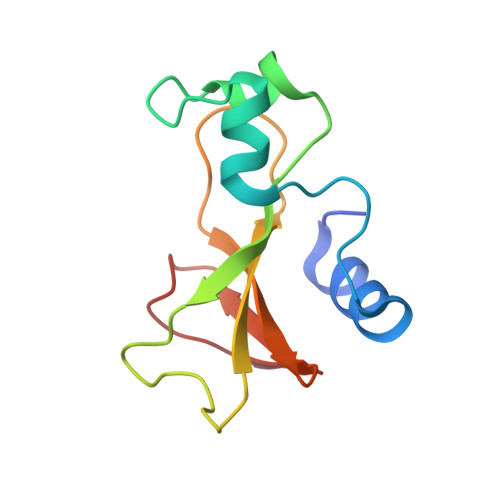Crystal structural analysis of mutations in the hydrophobic cores of barnase.
Buckle, A.M., Henrick, K., Fersht, A.R.(1993) J Mol Biology 234: 847-860
- PubMed: 8254677
- DOI: https://doi.org/10.1006/jmbi.1993.1630
- Primary Citation of Related Structures:
1BNI, 1BNJ, 1BSA, 1BSB, 1BSC, 1BSD, 1BSE - PubMed Abstract:
We have solved and analysed the crystal structures of five mutants in the hydrophobic core of barnase to investigate the structural basis for the contribution of hydrophobic residues and side-chain packing to the stability of globular proteins. In case ease, an amino acid side-chain has been replaced with one of smaller volume. The overall structures of four Ile-->Val mutants (residues 51, 76, 88 and 96) and one Leu-->Val mutant (residue 89) are all isomorphous with the wild-type structure. The magnitude and nature of structural shifts in the three hydrophobic core regions of barnase depend on the local environment of the substitution site, but have some features in common. (1) Side-chain atoms move to a greater extent than do main-chain atoms. (2) Repacking at the substitution site is achieved by either a rigid body shift of side-chain atoms (for Ile-->Val76 and Ile-->Val96 mutants), or by a combination of a side-chain shift and rotation (for Ile-->Val51 and Ile-->Val88 mutants). The mutated residue moves to the greatest extent, and generally in the direction of the created cavity (the largest atomic shift is 0.9 A, for Ile-->Val51). The space left behind from such shifts is not seen to be filled by neighbouring side-chains. (3) Where a cavity remains after mutation, it does not contain any solvent molecules. (4) There is no correlation between the extent of structural movements and the atomic temperature factors of atoms that have moved. (5) Structural movements are not large enough to disrupt hydrogen bonding. Valine 88, in the Ile-->Val88 mutant, is disordered and the electron density suggests several side-chain conformations. The reduction in the volumes of the cavities introduced upon mutation, due to collapse of the surrounding structure, ranges from 11% (Ile-->Val96) to 90% (Ile-->Val51).
- Centre for Protein Engineering, Medical Research Council Centre, Cambridge, U.K.
Organizational Affiliation:
















